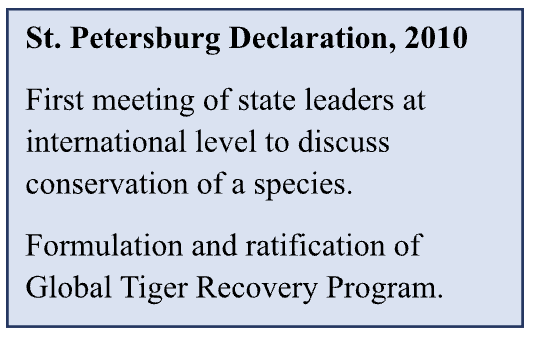The year 2023 marks the 50th year of ‘Project Tiger’. With a current population of about 2,967 tigers, India harbours approximate 70% global wild tiger population and the population is increasing at an annual rate of 6%.
HISTORY
- In 1973, Project Tiger was launched as a central government sponsored scheme assisted with assistance from World Wildlife Fund.
- It was inaugurated at Corbett tiger reserve with 9 tiger reserves – Corbett, Palamau, Similipal, Sundarbans, Manas, Ranthambhore, Kanha, Melghat and Bandipur.
- Today 18 States in India host 54 Tiger Reserves.
TIGER CATEGORIES: 8 Sub species of tigers recognized are:
- Bengal Tigers: Indian Subcontinent
- Caspian tiger: Turkey through central and west Asia (extinct)
- Amur tiger: Amur Rivers region of Russia and China, and North Korea
- Javan tiger: Java, Indonesia (extinct)
- South China tiger: South central China.
- Bali tiger: Bali, Indonesia (extinct).
- Sumatran tiger: Sumatra, Indonesia.
- Indo-Chinese tiger: Continental south-east Asia.
PROBLEMS FACED BY TIGERS
 Habitat loss
Habitat loss- Degradation
- Encroachment
- Human – tiger conflict
- Loss of tiger prey
- Illegal trade
WHY WE NEED TO CONSERVE TIGERS?
- Tiger is a conservation dependent species and an apex predator.
- Tiger serves as indicator and keystone species for conserving Asia’s forest systems ensuring viable populations of other endangered species.
- They are an important cultural symbol for several cultures in India.
- They are a major tourist attraction which generates revenue and supports local communities.
NATIONAL TIGER CCONSERVATION AUTHORITY
- Statutory body under Wildlife (Protection) Act, 1972
- Objectives
- Providing statutory authority to Project Tiger
- Fostering accountability of Center-State in management of Tiger Reserves
- Addressing livelihood interests of local people in areas surrounding Tiger Reserves.
FEW CONCEPTS RELATED TO PROJECT TIGER
- Core Buffer Corridor strategy
- Core area – legal status of national park/sanctuary – exclusive tiger area
- Buffer – peripheral area – mix of forest and non-forest land – inclusive people-oriented area
- Corridor – connects metapopulation of two or more tiger reserves
- Tiger Census
- Conducted every four years
- By National Tiger Conservation Authority along with Wildlife Institute of India.
- Uses double sampling method – ground survey and camera trap images.
- M-STrIPES
- Monitoring System for Tigers Intensive Protection and Ecological Status
- A mobile phone GPS-based patrolling application
- optimization of patrols through analysis of information collected by patrols and ecological evaluation
- E-eye
- sensor-based system of thermal, and visual cameras deployed along some sensitive borders of high-profile tiger reserves
- sensor-based system of thermal, and visual cameras deployed along some sensitive borders of high-profile tiger reserves
TIGER RANGE COUNTRIES
- Bangladesh
- Bhutan
- Cambodia
- China
- India
- Indonesia
- Lao PDR
- Malaysia
- Myanmar
- Nepal
- Russia
- Thailand
- Vietnam
Model Prisons Act 2023
The Supreme Court established a three-person committee in 2018 to study jail reforms nationwide and give suggestions on issues such as prison overpopulation.
The Ministry of Home Affairs (MHA) has prepared the Model Prisons Act 2023 to replace the Prisons Act of 1894. The new act will focus on the reformation and rehabilitation of inmates.
The Government of India has taken several steps to reform prisons in India, including:
- Appointing review committees at the state and district levels for under-trial prisoners
- Providing legal assistance to poor and vulnerable prisoners
- Improving prison conditions by providing proper food, clothing, and sanitation
- Providing basic amenities to inmates, such as clean drinking water, sanitation, and medical facilities
- Filling up vacancies of prison officers and staff in jails
- Conducting Aadhaar enrolment/updating camps for prison inmates
- Strengthening security arrangements in prisons
Prison reform is an attempt to improve conditions inside prisons, improve the effectiveness of a penal system, or implement alternatives to incarceration.
Prison reform is needed in India because of:
- Overcrowding
- Prisons are filled well beyond capacity. For example, in 2020, the Tihar Jail in Delhi held more than 15,000 prisoners, even though it has a capacity of around 7,000 inmates.
- Inhumane conditions
- Many Indian prisons have inhumane living conditions.
- Lack of rehabilitation
- There are inadequate social and rehabilitation programs.
- Lack of infrastructure
- Most jails in India lack basic infrastructure such as sleeping quarters, hygienic washrooms, and health clinics.
- Lack of budgetary support
- The budgetary support for the prison system has not increased proportionally to the population.
Other issues that contribute to the need for prison reform in India include:
- Prolonged detention of under trial prisoners
- Lack of legal aid availability for marginalized prisoners
- Lack of manpower and poor training
- Corruption
- Poor healthcare and welfare amenities
The Model Prisons Act, 2023 – The act replaces a colonial-era law.
It is a law that aims to address gaps in the existing Prisons Act. The act provides guidance on the use of technology in prison management. It also makes provisions for:
- Parole, furlough, and remission to prisoners to encourage good conduct
- Special provisions for women and transgender inmates
- Security assessment and segregation of prisoners
- Separate wards for women and transgenders
- Punishment for conniving jail staff
- Grievance redressal
- Prison development board
- Attitudinal change towards prisoners
The act also provides for:
- Individual sentence planning
- Classification and security assessment of prisoners
- Lodging prisoners in separate barracks/enclosures/cells in accordance with the assessment
Other NEWS
| The R21/Matrix-M |
|
| the indigenous Astra Beyond Visual Range (BVR) |
|
| Cholera |
|




